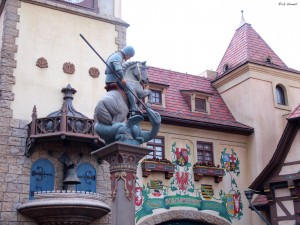
Disney’s Epcot Travel Pictures and Wallpapers
On the same trip in Orlando Florida. Epcot Center!
And St. George killing the dragon

Desktop Backgrounds and Cool Wallpapers.

Disney’s Epcot Travel Pictures and Wallpapers
On the same trip in Orlando Florida. Epcot Center!
And St. George killing the dragon

Desktop Backgrounds and Cool Wallpapers.
Native American Legends – Nootka
Captain John Meares states that the Nootka people had a great affinity for Copper. This was because many generations before meeting Meares, an old man came to visit them. He arrived in a copper canoe with copper paddles and told them that he came from the sky.
The Nootka then killed the old man, and took his copper.
pg 123 – “First Approaches to the Northwest Coast”
Also interesting to note is that the Nootka were cannibals. They lived on the west side of Vancouver Island, British Columbia.
The Tale of Chief Bigfoot
In American history there are two Chief Bigfoots, Chief Big Foot of the Lakodas who was killed by the US Calvary on December 29, 1890, and Chief Bigfoot who led raids against settlers in the Eastern Oregon, Northern Nevada and South Eastern Idaho area during the 1860s.
The western Chief Bigfoot was the leader of the remains of the Paiute, Bannock and Shoshone Indians tribes. This combined tribe of Indians was rogue, having resisted resettlement to reservations. He was known by several names, Nam-Puh, We-ah-we-ha, and Oulux. The town of Nampa Idaho was named after him, Nam-Puh meaning “Big Foot” in the Bannock Language. As you’ll see below, the full extent of Chief Bigfoot and his tribe’s activities is unknown, but they were a real worry to settlers in the area during the Snake Wars. He and his tribe would steal horses, set remote farms on fire, kill sheep, etc.
He was a tall man, described by Idaho pioneer John Hailey in “History of Idaho” as “six foot eight inches tall, and weighing two hundred and eighty pounds.” His foot print in moccasins was seventeen and a half inches long by six inches wide. The size of his foot led many local boys to make “Chief Bigfoot” tracks and then play practical jokes with the Chief to blame.
His story has been stretched quite a bit, not only over the years, but during his own lifetime. It doesn’t help that one of the tertiary sources tries to create a link between Chief Bigfoot and Sasquatch. The author of that book apparently believes that all Bigfoot sightings in the area are actually actually a taller, hairier, and miraculously 180 year old, Chief Bigfoot. The core of his story weaves between these two facts, attempting to blend them together.
Another stretching of the truth was in November 1878. Author William T. Anderson published an account in the “Idaho Statesman,” of Chief Bigfoot’s demise. This story adds a few “facts” that are short on proof of any sort. Of course the original article was published as a serial so truth was probably stretched even more. Like many Western Stories of the day, just enough facts and truth were applied to give the story enough elements of truth to be believable. Unfortunately this story was taken as fact for some time to the point that Pioneer Descendants had a brass plaque erected on the Snake River near Bigfoot Canyon repeating the tale below.
The story, as outlined in the Idaho Statesman, starts with real life figure John Wheeler, a known highwayman and gunman who lived near Silver City, Idaho. Wheeler had successfully held up a stage coach in Oregon, and was killed a few years later while trying to do so again in Arizona.
According to Anderson; “… after lying in wait for three days, Wheeler trapped Bigfoot, challenged him, and the battle was on. The duel took place in what became known as Bigfoot Canyon, a few miles south of Snake River, on the stage route to Silver City. When the shooting ended and the gunsmoke cleared, Bigfoot lay prostrate in the dust, twelve bullets from a Henry rifle in his body. Though both his legs and one of his arms were broken, he still was considered so dangerous that when he asked for a drink of water, Wheeler replied:
‘Hold on till I break the other arm, old rooster; then I’ll give you a drink.’
‘Well, do it quick,” Bigfoot said, ‘and give me a drink and let me die.”
Anderson states that Wheeler did both, and then gave the Chief a swig of whiskey and ammonia “in case of snakebite” at his request. “The Indian drank it, every drop, and then fell back apparently dead. After a few minutes he revived, and said that he was better.”
The Chief then told Wheeler his life story. Note that at this point he had four broken limbs and twelve bullet holes from a .44 in his body. Anyways, he had been born to a half Cherokee half Negro woman, and a white man named Archer Wilkinson. Wilkinson had been hanged for murder but his mother was a good, religious woman. His actual name was Starr Wilkinson, he was six foot eight and a half, 300 pounds and had been called “Bigfoot” as long as he could remember.
He drove a wagon west as part of a emigrant train in 1856 in return for room and board. He fell in love with a young lady on the train, who returned his interest until an artist from New York City joined the train. Suspecting the artist had bad mouthed him, an argument started while the two men were rounding up the stock one morning near Goose Creek Mountains. The artist admitted to having made derogatory references to Wilkinson’s parentage to the young lady.
“This made me mad, and I told him if he called me that again I would kill him. So he drew his gun on me and repeated it. I was unarmed, but started at him. He shot me in the side but did not hurt me much, so I grabbed him and threw him down, and choked him to death, then threw him into Snake River, took his gun, pistol and knife and ran off into the hills.”
Anderson writes that Joe Lewis, of the Whitman Massacre, was his chief aide. As vengeance, they planned and carried out the Ward Massacre (which happened in 1854 – two years before Wilkinson came over on the wagon train,) the Otter Massacre in 1860, and the young lady he had once been interested in along with countless other killings.
Wilkinson found that Wheeler was also part Cherokee and asked him two favors – that none be told of his death and that his body was to be buried where it could never be found. Wheeler agreed, and Chief Bigfoot died content.
General George S. Crook finally ended what became known as the Snake Indian Wars in 1868. He wrote in his memoirs that he had sighted an Indian named Bigfoot who appeared to be a Paiute. He stood over six feet tall, had a moccasin track of fourteen and half inches long, and could run down jackrabbits.